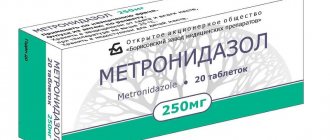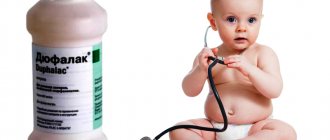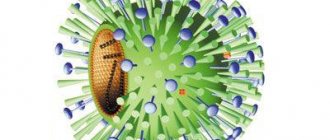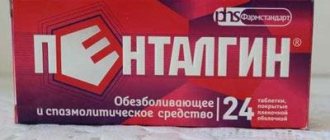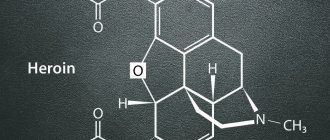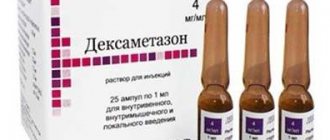The level of potassium in the body affects many metabolic processes and is associated with water-salt balance. A deficiency or excess of this element causes unfavorable disturbances in the functioning of muscles, including the myocardium, which can cause dangerous rhythm disturbances.
Potassium enters the body with food, with the exception of pure sugars and fats; all foods contain it. Plays an important role in the regulation of electrolyte balance and is necessary for the normal functioning of cells. Typical symptoms indicating a deficiency or excess of potassium are disturbances in the functioning of skeletal and smooth muscles and cardiac muscle.
Reasons for oversupply
A lethal dosage for the human body has not been established, however, in increased concentrations, magnesium is toxic. If the norm is prolonged, poisoning cannot be avoided, especially when combined with phosphorus and calcium.
An excess of magnesium can be observed when using antacids in the treatment of gastritis with increased acidity of gastric juice. This type of preparation also contains magnesium. Chronic renal failure may also be the cause.
Note to the patient
It is forbidden to carry out treatment at home - self-medication will only do harm. To identify the reason that provoked the increase in magnesium concentration in the blood, it is important to carry out a diagnosis. Many medications cause side effects, so you should not risk your health and randomly select medications for treatment. Regular medical examination is the best preventative measure for all diseases.
Symptoms of magnesium overdose
Too much magnesium in the human body has a negative effect on well-being. This condition is characterized by a number of symptoms and occurs against the background of certain causes. These may include metabolic disorders of this substance or its entry into the body in excessive quantities.
Symptoms of magnesium overdose in adults are very unpleasant. Internal organs are damaged, including the kidneys, which cannot independently remove the excess of the element. Impaired functioning, in turn, leads to the development of serious pathologies. These include chronic renal failure and dehydration.
Importance of potassium for the human body
The role of potassium in the body cannot be overestimated. It promotes the proper functioning of the heart and blood vessels and keeps the muscular system in good shape . In addition, potassium helps the human liver and kidneys, endocrine glands and even the brain function smoothly. In addition, potassium is a mineral element that prevents the development of diseases such as atherosclerosis, and chronic fatigue, apathy and depression do not threaten those who receive the required amount of this substance from food every day.
Dyslexia and other pathologies
In addition to the above, the development of dyslexia is noted. This is a condition in which the patient is unable to master reading skills. The activity of the parathyroid and thyroid glands increases. With an increased magnesium content, a person also develops psoriasis and arthritis, and stones are deposited in the kidneys. That is why it is so important to promptly identify the symptoms of an overdose of Magnesium B6.
With a constant excess of this substance in the human body, muscles begin to suffer. At the initial stage of development of the pathology, this is expressed by muscle atrophy, weakness or rapid fatigue. Next, there is a disruption in the functioning of the nervous system and a slowdown in the thought process. A person becomes indifferent and apathetic towards various things. There is a decrease in blood pressure.
Prevention
In order to prevent excess magnesium, it is recommended to take medications that remove excess mineral along with waste products. These medications include organic salts, which neutralize most drugs containing magnesium (Magnerot).
To remove orotic acid, it is necessary to stimulate the synthesis of nucleic acids in order to enhance processes in regenerative tissues.
The substances affect metabolism, also forming albumin in the liver. During normal kidney function, magnesium is excreted within 3-4 days. If a pathology (pyelonephritis) is detected, the properties of the first membrane-stabilizing channel, which blocks calcium ducts, should be combined.
The concentration of magnesium in the cell depends on the amount of calcium, so the primary measures may be those aimed at removing potassium and calcium.
Persons suffering from diabetes, coronary artery disease, and myocardium are recommended to eat foods containing magnesium without additional vitamin intake.
Progression of symptoms
If timely measures are not taken to reduce magnesium levels, symptoms will continue to develop. This will have a bad effect on the functionality of the entire body. Therefore, when the first symptoms of an overdose of Magnesium B6 occur in adults, it is recommended to see a doctor and conduct a full examination.
If the excess becomes chronic, then the muscle lethargy and weakness that was observed initially can result in complete paralysis for the person. This is a reaction not only from the musculoskeletal system, but also, most importantly, from the respiratory system.
Correction of the amount of substance
If the excess is caused by diseases, then to correct its content it is necessary to urgently begin their therapy. When an excess of an element is caused by the use of potassium-containing drugs, you can take a course using drugs that help remove the substance from the body.
Medication method
Unithiol - a universal antidote
The antidote for potassium poisoning is tocopherol acetate. It is administered during the first day after intoxication in an amount corresponding to 0.7 g.
Unithiol, which does not have a high degree of toxicity, can become a medicinal universal antidote.
Elements such as sodium, cesium, as well as thallium and rubidium are capable of removing substances from tissues.
Excessive consumption of sugar, alcoholic beverages, coffee, medications containing cortisone, as well as colchicine and laxatives also interfere with potassium absorption.
In addition, when treating excess potassium, diuretics and drugs containing a cation exchange resin are prescribed. It is not absorbed by the body.
In particularly severe conditions the following are indicated:
- dialysis;
- administration of glucose, as well as calcium and insulin solution.
Moreover, calcium, as an antidote, plays the role of a barrier that protects the heart from the effects of potassium. And an antidote such as a solution of glucose and insulin promotes its elimination from the bloodstream into the tissues.
Overdose of the drug "Magnesium plus B6"
If the kidneys are functioning normally, oral magnesium does not cause toxic reactions. Poisoning can only occur in cases of renal failure.
Poisoning leads to decreased blood pressure, nausea, vomiting, slowed reflexes, ECG changes, respiratory depression, coma, cardiac arrest, and anuria. For therapeutic purposes, rehydration and forced diuresis are used. Magnesium antagonists - calcium chloride or calcium gluconate - are used as an antidote. Hemodialysis or peritoneal dialysis is necessary for kidney failure.
Now about what to do if there are symptoms of an overdose of Magnesium B6.
Side effects of Panangin
Have you been struggling with HYPERTENSION for many years without success?
Head of the Institute: “You will be amazed at how easy it is to cure hypertension by taking it every day...
Read more "
Most medications can only be taken as prescribed by a doctor. Panangin is no exception. To avoid possible negative consequences, you should know what the side effects and contraindications of Panangin are. Following the recommendations for taking the drug will help prevent complications and undesirable consequences during treatment.
Composition and effect of the drug
The use of Panangin is indicated for patients to replenish magnesium and potassium in the body against the background of various cardiovascular diseases. The drug contains such active ingredients as magnesium and potassium aspartate. With a lack of these intracellular cations, metabolic processes throughout the body are disrupted, in particular in the heart muscle, which leads to the development of pathologies such as arrhythmia, arterial hypertension, coronary heart disease, organ conduction disorders and others.
Panangin is produced in the form of tablets and solution for injection. The tablets have a round, biconvex shape, white or grayish tint, without any obvious taste or odor. The solution for injections is transparent, packaged in cardboard packages of 5 ampoules with a dosage of 20 mg.
The drug has a number of analogues. Among them are Plus vitamin B6 Panangin, Asparkam, Aspangin and others. They all include potassium and magnesium and have their own indications, contraindications and side effects.
Indications
The scope of the medicine is quite limited. Panangin is prescribed to patients for the following conditions:
- myocardial infarction;
- heart rhythm disturbances;
- chronic cardiac pathologies;
- treatment of side effects while taking cardiac glycosides;
- arterial hypertension.
Panangin is prescribed mainly as a complex therapy. The product is well tolerated by patients, has positive reviews, and when used correctly, rarely causes side effects.
Contraindications
When prescribing the drug, the doctor must take into account the contraindications for Panangin, since failure to comply with these prohibitions can provoke serious consequences for the life and health of the patient.
Tablets and solution for intravenous administration have similar contraindications, but there are also differences.
Tablets are not used for the following conditions:
- kidney failure with acute or chronic course. The active components of Panangin, entering the body, are metabolized in the liver and excreted by the kidneys. If the functioning of an organ is disrupted, the medicine is not completely eliminated from the body and accumulates in the tissues. This provokes the risk of developing hyperkalemia and hypermagnesemia;
- 1st degree atrioventricular block or impaired conduction of electrical impulses between the atria and ventricle;
- neuromuscular disorders due to autoimmune diseases (muscular myasthenia gravis);
- disturbance of water-electrolyte balance - dehydration;
- disturbance of acid-base balance - acidosis;
- release of pathological hemoglobin due to the destruction of red blood cells - hemolysis.
Contraindications to the use of injections:
- kidney pathologies. As in the first case, injections are not administered to patients with impaired functioning of the urinary system due to the risk of developing an excess of magnesium and potassium in the body;
- excess potassium in the blood;
- excess magnesium in the blood;
- atrioventricular block 1–2 degrees;
- pressure drop below 90 mmHg;
- cardiogenic shock;
- disruption of hormone synthesis by the adrenal cortex;
- impaired urination, decreased urine output;
- complete cessation of urine output - anuria.
Is Panangin contraindicated for pregnant women?
There are no direct contraindications to the use of the medicine during pregnancy, but it should be used with extreme caution during this delicate period, only under the supervision of a leading doctor.
Features of use during pregnancy:
- Panangin should be used only on the recommendation of a specialist, in case of emergency;
- to prevent excess electrolytes in the body during therapy, laboratory blood tests should be carried out regularly;
- It is recommended for pregnant women to prescribe the drug in tablet form; injections are used less frequently;
- if even minor signs of intolerance to Panangin develop, the medication should be abandoned;
- When prescribing a drug, the doctor must take into account the drug interactions of the drug being described.
Every woman should remember that any medications during pregnancy can cause negative consequences for her body and the health of the child. Using Panangin on your own or changing its dosage is strictly prohibited.
Side effects
Side effects of Panangin occur mainly when contraindications are not followed or when the doctor’s instructions for using the product are not followed. Among the negative consequences are the following:
Why do you feed pharmacies if hypertension is afraid of the usual like fire...
Tabakov has revealed a unique remedy against hypertension! To reduce blood pressure while preserving blood vessels, add to…
- pain, cramps in the stomach and intestines;
- headache, nausea;
- bowel dysfunction - diarrhea or, conversely, constipation;
- increased sweating;
- dryness of the oral mucosa;
- fluctuations in blood pressure;
- difficulty breathing, bronchospasm;
- feeling of heat;
- heart rhythm disturbances, AV block.
Symptoms of hyperkalemia
Hyperkalemia or excess potassium in the body causes symptoms such as decreased urine output, vomiting, stomach pain, increased fatigue, muscle weakness, cramps, swelling of the extremities, and irritability.
Treatment is carried out by discontinuing the drug and following a special diet. In severe situations, the patient is given a chloride solution and calcium gluconate; less often, hemodialysis is required.
Symptoms of hypermagnesemia
Hypermagnesemia causes changes in electrocardiogram readings, a drop in pressure, drowsiness, impaired respiratory function, slow heart rate, nausea and other symptoms.
As with hyperkalemia, treatment is carried out by administering a saline solution of calcium and sodium chloride; in especially severe cases, hemodialysis is used.
If the above-described manifestations develop, you should immediately stop taking Panangin and consult a doctor. Self-medication is life-threatening.
Overdose
An overdose of Panangin causes the following manifestations in the patient:
- feeling of anxiety, restlessness;
- severe slowing of heart rate;
- diarrhea;
- dry mouth;
- epigastric pain;
- feeling of strong heartbeat;
- muscle weakness;
- paralysis of limbs.
To provide first aid, the patient should be given plenty of clean water and any sorbent. Activated carbon, Smecta, White carbon, Polysorb, etc. are suitable. If the condition does not improve, you need to go to the hospital.
Patient reviews
Vitaly, Vladivostok “Panangin is a more expensive analogue of Asparkam, but the active ingredient is the same. I take this drug in courses 1-2 times a year, since I suffered a heart attack and often suffer from arrhythmia and fluctuations in blood pressure. During all the time I used it, I didn’t notice any side effects, the tablets are good.”
Anna, Sevastopol “Unpleasant symptoms in the heart area began to appear after I was 35 years old. I began to notice a pulling sensation, tingling, burning sensation. After going to the hospital, I was not diagnosed with any serious illnesses, but Panangin was prescribed. I took the medicine for 3 weeks, 3 tablets a day, and negative symptoms began to occur less frequently. The price and quality of the drug are quite satisfactory.”
Natalya, Cherepovets “I am a doctor myself and I know that it is important to maintain normal levels of electrolytes in the body. To maintain your heart, take Panangin in courses of 2 weeks twice a year. Of course, I do not recommend using the drug on your own for other patients; it is better to consult a doctor. “I believe that this medicine well replenishes potassium and magnesium in the blood and helps prevent many complications.”
Acute magnesium poisoning: first aid
It is necessary to stop the absorption of magnesium into the blood. For this purpose, when taking the drug orally, you need to rinse the stomach with an impressive amount of water.
You should definitely call an ambulance. Only specialists will be able to administer intravenously a drug containing calcium so that it neutralizes magnesium.
The medical facility will constantly monitor the content of magnesium ions in the blood and urine. Experts will also determine the reason why the body cannot independently remove an excess of the element. If renal failure is detected, peritoneal dialysis or hemodialysis is performed. If after this the level of magnesium in the blood is also elevated, additional studies are carried out to diagnose cancer or dysfunction of the thyroid gland and adrenal glands. This is why an overdose of magnesium in the body is very dangerous.
Consequences for the body
Expert opinion
Kovaleva Elena Anatolyevna
Doctor-Laboratory Assistant. 14 years of experience in clinical diagnostic services.
Ask a question to an expert
The consequences of excess potassium can be tachycardia, digestive disorders, painful cramps, in severe cases - paralysis, accidents associated with loss of muscle strength (falls, for example), changes in blood pressure and associated discomfort.
Much more than an adult, the baby and fetus need potassium. Therefore, pregnant women need to constantly consume sufficient amounts of this metal.
How to normalize the condition? Therapy
The only treatment option is to normalize the magnesium content in the body. However, before using various therapeutic methods, you need to consult a specialist so as not to convert an excess into a deficiency.
Your doctor may prescribe diuretics and drink plenty of fluids. After some time of such simple therapy, magnesium levels return to normal. It is prohibited to take diuretics on your own, since an incorrectly prescribed drug will remove beneficial potassium from the body.
When there is no point in using diuretics due to the development of kidney failure, hemodialysis is used, that is, a special device that, like kidneys, filters blood through itself and returns it back to the body. It is popularly called an “artificial kidney.” This is not the most pleasant procedure; it is quite lengthy, lasting about six hours. It should be done approximately three times a week. However, it is precisely this manipulation in case of impaired kidney function that helps remove excess magnesium, and sometimes even preserves and prolongs life.
What are the symptoms of magnesium overdose during pregnancy?
Daily norm of an element
To determine whether there is an excess of an element or not, you need to know how much of it you need to get per day to feel good. The daily diet should contain from 350 to 500 mg of magnesium . About 50% of this dose enters the body with cereals and grains. In women during pregnancy, the need for it increases to 1 g per day. That is why magnesium B6 is so often prescribed during this period. In addition to magnesium, vitamin B6, which is included in the composition, improves the absorption of the main substance, and also has a positive effect on the heart and central nervous system, which is important during the period of bearing a child.
Demands for the element increase:
- due to regular stress;
- during physical and mental stress;
- due to taking certain medications;
- in persons suffering from chronic alcoholism.
During pregnancy
When carrying a baby, you may also experience excess magnesium. During pregnancy, the reasons for this condition are as follows:
- hypothyroidism (decreased activity of the thyroid gland);
- adrenal and kidney disease;
- self-medication;
- drug overdose (this condition may occur during treatment of kidney failure, eclampsia, or a decrease in the volume of fluid in the body).
During pregnancy, other symptoms occur, which manifest themselves in the form of diplopia (double vision). Increased sweating, a flush of heat to the face, headache, and nausea may occur. Speech becomes slurred, becomes sluggish, and blood pressure decreases. An overdose does not just go away for a pregnant woman’s body. Brain activity is inhibited, mood and vitality deteriorate, and you constantly want to sleep. Blood pressure rises and the functioning of the cardiovascular system is disrupted. As a result, the respiratory muscles can paralyze, and the woman loses consciousness.
Excess cannot be diagnosed by symptoms alone. To do this, early on or even when planning pregnancy, you need to determine the magnesium content in the body. For this purpose, many laboratory and diagnostic research methods are carried out. One of them is a serum absorption study with the addition of xylydyl blue.
Berthollet salt poisoning
Potassium chlorate, or bertholite salt, is a toxic and explosive substance that is widely used in many industrial sectors. To answer the question of where this substance is used, it is enough to know the composition of an ordinary match, because in addition to sulfur, potassium chlorate is also added there. In appearance, Berthollet salt is white or transparent crystals with a salty taste, which, if ingested, pose a great danger to human life.
When potassium chlorate enters the body, a person feels acute pain in the stomach . Poisoning with Bertholet salt is accompanied by such body reactions as hiccups, vomiting of black and yellow masses, diarrhea, pale skin, blood from the nose, increased heart rate and loss of consciousness. Severe headache, shortness of breath, delirium, enlarged liver, coma and acute heart failure are also observed.
The victim needs to apply a cold compress or piece of ice to his head and pour a stream of cold water over his back. If possible, give the person a few pieces of ice to swallow.
Sources of magnesium
Symptoms of magnesium excess occur when too much of it enters the body. This element comes from food. For example, there is a lot of magnesium in millet and buckwheat, which everyone can afford.
Magnesium is also found in meat, especially in ham and liver. Less in rabbit meat, pork, veal. Sausage is also a source of magnesium.
If there are signs of magnesium excess, you cannot treat yourself; it is important to consult a doctor and determine the cause.
An overdose of potassium and magnesium is also dangerous.
Treatment of potassium deficiency
The main way to replenish chronic potassium deficiency is to introduce an appropriate diet. It should contain a lot of plant seeds (preferably legumes), dried fruits, fruit juices, leafy green vegetables, cocoa .
Acute hypokalemia is treated using intravenous or oral potassium supplements and, if possible, eliminating the primary cause of its deficiency. Of course, the administration of large, therapeutic doses of potassium should be carried out under the supervision of laboratory tests so as not to lead to overdose and hyperkalemia.
Extrasystole of the heart: treatment, symptoms
Extrasystole is a type of arrhythmia, premature contraction of the heart. It occurs as a result of the formation of an additional impulse in an ectopic or heterotopic focus of excitation.
Types of cardiac excitability disorders
Taking into account the place of occurrence of electrical excitation, extrasystoles are:
- atrial,
- ventricular,
- atrioventricular.
Atrial extrasystole – the zone of excitation is the atria.
The cardiogram changed in such cases differs from the normal one in the reduced size of the P wave. If an extraordinary impulse appears in the area of the atrioventricular node, the excitation wave has an unusual direction. A negative P wave occurs. Ventricular extrasystole - additional impulses occur only in one of the ventricles and cause an extraordinary contraction of this particular ventricle. This type of extrasystole on the ECG is characterized by the absence of the P wave, prolongation of the interval between the extrasystole and the normal contraction of the heart. The interval before the extrasystole, on the contrary, is shortened. Extraordinary contraction of the ventricles does not affect the functioning of the atria.
Atrioventricular extrasystole - the atrioventricular node is considered the zone of excitation. In this case, the excitation wave in the atrium has the opposite direction to the usual one. But excitation through the trunk of the His bundle, through the conduction system of the ventricles, is carried out in the usual way. Atrioventricular extrasystoles are characterized by a negative P wave, recorded in different parts of the node.
Supraventricular extrasystole is another name for extraordinary ectopic contractions of the heart that occur in the atria and atrioventricular node. All types of extrasystoles that appear in the upper parts of the heart, that is, above the ventricles, are supraventricular extrasystoles.
Extrasystoles that appear in different foci and are characterized by a polymorphic ECG are polytopic. According to the number of extrasystoles, they can be single, paired, or group. When an extrasystole occurs after a normal heart contraction, bigeminy develops.
The mechanism of occurrence of extraordinary contractions of the heart
In many ways, cardiac extrasystole is associated with nervous factors. The fact is that the ventricles of the heart are under the influence of the parasympathetic nervous system. If the heart is weakened, the amplifying nerve not only increases the strength and frequency of heart contractions. It simultaneously increases the excitability of the ventricles, which leads to the appearance of extrasystole.
An important role in the mechanism of arrhythmias is played by disturbances in electrolyte metabolism of a local or general nature. When the concentration of potassium, sodium, magnesium changes inside and outside the cell, it affects intracellular excitability and contributes to the occurrence of arrhythmias.
Why does rhythm disturbance occur?
The cause of extrasystole is a violation of the excitability of the heart. Extrasystole accompanies many diseases, such as myocarditis, ischemic heart disease, cardiosclerosis, rheumatism, heart defects and other diseases. But in half the cases it is not connected with them in any way. Other reasons:
- reflex effects from internal organs (for cholecystitis, diseases of the genital organs, stomach);
- overdose of cardiac glycosides, abuse of diuretics, antiarrhythmic drugs;
- imbalance of electrolytes sodium, potassium, magnesium;
- consumption of stimulants - large amounts of coffee, alcohol, energy drinks;
- high physical activity;
- neuroses, psychoneuroses, labile cardiovascular system;
- endocrine diseases – thyrotoxicosis, hypothyroidism;
- chronic infections.
The causes of supraventricular extrasystole, as one of the supraventricular arrhythmias, are the same as those listed above.
Extrasystole with osteochondrosis has recently become a common occurrence. Its appearance is associated with degenerative-dystrophic changes in the thoracic spine. The nerve roots and plexuses located in this area can be pinched and disrupt the innervation of the heart and other organs.
Extrasystole during pregnancy occurs in half of expectant mothers 2–3 months before birth. During this period, the woman’s body experiences the highest stress. Treatment of cardiac extrasystole in pregnant women is impossible without finding out the cause, and they can be different. And the treatment should not have a negative effect on the fetus. Therefore, immediately see a cardiologist.
How to react to an extraordinary contraction of the heart
One category of people does not feel extrasystole at all. Arrhythmia is discovered accidentally during auscultation, taking a cardiogram when visiting a doctor for another reason. Some patients perceive it as freezing, cardiac arrest, a blow, jolts to the chest. If group extrasystoles occur, symptoms of arrhythmia may be accompanied by slight dizziness and a feeling of lack of air.
In most cases, single extrasystoles are harmless. Short, frequent (6–8 per minute), group and polytopic extraordinary contractions of the heart can have adverse consequences. Why is extrasystole of these types dangerous?
It is sometimes preceded by more severe types of arrhythmias - paroxysmal tachycardia with a number of contractions up to 240 per minute and atrial fibrillation. The latter is accompanied by uncoordinated contractions of the myocardium. A serious heart rhythm disorder, such as extrasystole, can provoke ventricular fibrillation.
Therefore, if you experience any discomfort in the heart area, you should seek medical help.
Foods rich in potassium
Fortunately, potassium is as abundant in nature as it is needed by our bodies. For example, from a 200 gram serving of potatoes we get 20% of the daily minimum potassium.
Dried apricots - 1511 mg of potassium per 100 g (31% of the Daily Value);
Of course, bananas contain potassium, but they are not the best source of this mineral. In addition, it is important to know that when food is processed, more potassium is destroyed.
Potassium is contained in foods (per 100 grams):
- Cocoa powder – 1524 mg (32% Daily Value);
- Dried apricots - 1511 mg (31% Daily Value);
- White beans - 1189 mg (28% Daily Value);
- Pistachios - 1042 mg (22% Daily Value);
- Beet leaves – 900 mg (25% Daily Value);
- Pumpkin seeds – 788 mg (17% Daily Value);
- Raisins - 649 mg (16% DV)
- Almonds – 705 mg (15% DV)
- Dates – 656 mg (14% DV);
- Chard – 548 mg (12% Daily Value);
- Potatoes – 534 mg (13% DV)
- Soy – 514 mg (12% DV)
- Amaranth seeds – 508 mg (11% DV)
- Avocado – 484 mg (11% DV)
- Spinach – 466 mg (10% Daily Value)
- Sweet Potatoes – 475 mg (11% DV)
- Walnut (441 mg (9% DV));
- Oatmeal – 429 mg (9% DV);
- Chia seeds – 407 mg (9% DM);
- Brussels sprouts – 389 mg (8% DV);
- Lentils – 370 mg (8% DV);
- Bananas – 358 mg (8% DV);
- Carrots – 320 mg (7% DV);
- Broccoli – 316 mg (7% DV);
- Beetroot – 305 mg (6% DV);
- Tomatoes – 237 mg (5% DV).
There are enough products containing potassium, therefore, even without trying very hard, our body will receive as much as it needs. Those who consume insufficient amounts of fruits and vegetables, and prefer meat and processed food, and fast food, should seriously think about it. In addition, you should remember the ratio of sodium and potassium, in order for potassium to be absorbed and beneficial, you need to limit your intake of sodium, that is, salt.
We have been familiar with potassium (K) since school, when in chemistry lessons we looked at the periodic system of chemical elements by D.I. Mendeleev. Potassium is an alkali metal
, with atomic number – 19. Color – silvery-white. A large amount of it is found in minerals, and is found mainly in combination with other chemical elements.
It ranks seventh in abundance among the elements of the earth's crust. So we gave you a little chemistry lesson.
Lack and excess of potassium. Symptoms and risks
How much potassium does a person need depending on age:
- 0-6 months - 400 mg;
- 7-12 months - 700 mg;
- 1-3 years - 3 g;
- 4-8 years - 3.8 g;
- 9-13 years - 4.5 g;
- from 19 years old - 4.7 g;
- Nursing mothers - 5.1 g.
Potassium deficiency most often occurs when:
- Taking diuretics;
- Consumption of foods high in sodium (salt);
- If the body's ability to absorb food is impaired;
- Abuse of smoking, alcohol;
- Consumption of narcotic substances.
Lack of potassium in the body. First symptoms:
- Loss of appetite;
- Muscle weakness;
- Arrhythmia;
- Drowsiness;
- Constipation.
Risks associated with long-term potassium deficiency:
- Development of diseases of the cardiovascular system;
- Increased risk of stroke;
- Infertility;
- Arthrosis;
- Various forms of cancer;
- Disruption of the digestive system.
Excess potassium can only occur with uncontrolled use of supplements and multivitamins. You must always be extremely careful. Yes, vitamins are certainly useful, but strictly within normal limits and best from food. Take pharmaceutical medications only as recommended by your doctor.
Symptoms of excess potassium may include:
- Low blood pressure;
- Irregular heartbeat;
- Weakness;
- Edema;
- Anemia.
For normal absorption of potassium, the body needs a sufficient amount of magnesium. To ensure that potassium is well absorbed, it is important to eat more fruits and vegetables and fewer foods high in salt, i.e. sodium.
Potassium in food
Potassium can be found in many foods, both plant and animal. With a balanced diet, a person receives a sufficient amount of this mineral, which allows our organs and systems to function smoothly.
Let's look at potassium-rich foods by season
.
Summer-autumn period
Summer and autumn are the best time to be saturated with all vitamins and microelements. At this time, it is necessary to supply your body with such products as:
- tomatoes;
- cucumbers;
- grape;
- apricots;
- currant;
- salad;
- spinach;
- asparagus;
- parsley;
- radish;
- peas;
- corn;
- watermelons and melons;
- bread made from rye flour;
- broccoli;
- milk;
- fish.
Winter and spring products
In winter and spring we get potassium from the following products:
- fish;
- meat;
- milk;
- baked potato;
- prunes;
- legumes;
- bananas;
- carrot;
- cabbage;
- dried apricots and raisins;
- citrus;
- avocado;
- garlic;
- Rye bread;
- oatmeal and cereals.
Baked potatoes must be eaten with the skin on. This vegetable is available in any season and is inexpensive. But the benefits from it are enormous.
Try to start your morning with cereals - or oatmeal. In addition to them, drink a glass of milk or kefir. Energy and vigor will accompany you all day.
Between meals, it is useful to include citrus products, banana or grated carrots with honey. This snack will enrich you not only with potassium, but also with a whole spectrum of vitamins.
If you want to drink tea, put the buns and sweets aside, and put a bowl of dried apricots, figs, prunes and raisins. Such sweets will only bring great benefits to the body.
How to preserve potassium when cooking?
Fruits are recommended for consumption raw, then potassium and all useful components do not lose their properties. If it is a sour fruit, you can add a little. All kinds of fruit purees are made for children using a blender.
Vegetables are served boiled, baked and raw. A raw food diet is ideal, but if heat treatment is needed, it is better to prefer baked foods. In no case should you overcook vegetables until they lose their appearance; let them remain slightly undercooked. Our goal is to preserve the potassium content and all useful substances as much as possible.
Oatmeal can be poured with warm milk or water, and allowed to stand for 30 minutes under the lid, covered with a towel on top. Then you can add fruit or raisins.
It is better to add water to the buckwheat in the evening and leave it overnight. In the morning, when you wake up, the buckwheat is ready. It should be heated over a fire and salt should be added to taste. A glass of fermented baked milk or yogurt would be a good addition. This breakfast reduces blood sugar and cleanses blood vessels.
If possible, include avocados in your diet - an invaluable source of potassium.
. Avocado pulp goes well with eggs, onions, vegetables, lemon, shrimp and salmon. You can prepare a variety of unusual and nutritious salads. Astronauts must include this fruit in their diet.
Potassium mixture recipe
Dried fruits: figs, raisins, prunes and dried apricots are used to prepare a potassium mixture.
We take 300 grams of all dried fruits and grind them in a meat grinder. To this mixture add 1.5 cups of chopped walnuts, two twisted lemons and a glass of honey, preferably May honey. Mix everything thoroughly and leave to store in a cool place. Eat a dessert spoon three times a day in between meals.
Potassium is very important for the body. The condition of soft tissues and the functioning of many systems, including nervous, excretory, bone, and muscle, depend on it.
98% of potassium is located in tissue cells, and the remaining 2% is in the intercellular space. Its deficiency or excess can lead to serious problems.
